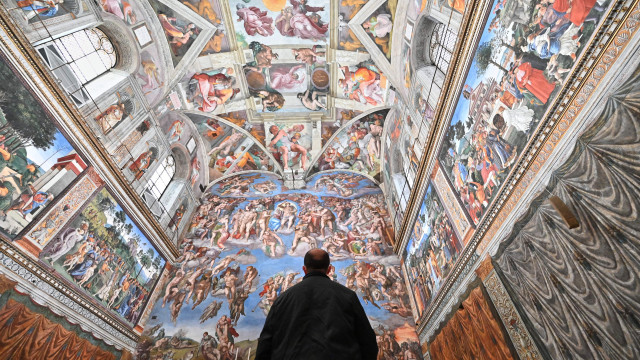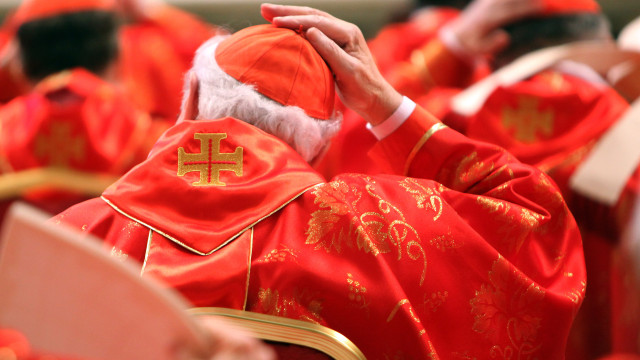






























© Getty Images
0 / 31 Fotos
A historic landmark
-
The Sistine Chapel is located within Vatican City and is one of the most famous religious and artistic sites in the world. It was completed in 1481 under the direction of Pope Sixtus IV, after whom it is named. Since the 15th century, the chapel has been the site of the papal conclave, the process by which new popes are chosen. Over the centuries, more than 50 popes have been elected in the Sistine Chapel, under the gaze of Michelangelo’s renowned frescoes, including the iconic 'Last Judgment' and the ceiling depicting scenes from the Book of Genesis.
© Getty Images
1 / 31 Fotos
The divine paradox
- The ceiling of the Sistine Chapel is widely considered the most ambitious painting in history. But it isn’t just religious decoration—it’s a swirling epic of prophecy, poetry, and theology rendered through sculptural flesh and spiritual energy.
© Getty Images
2 / 31 Fotos
A reluctant painter
- Michelangelo was not a painter by trade when Pope Julius II commissioned him to fresco the chapel in 1508. He was a sculptor, a master of marble who felt uneasy holding a brush, especially on such a massive scale.
© Getty Images
3 / 31 Fotos
Anatomic brushstrokes
- What makes Michelangelo’s frescoes so unusual is the anatomy. The 343 figures possess weight, mass, and presence. He didn’t paint so much as carve in pigment, borrowing the physique of classical statues to render holy bodies in motion.
© Getty Images
4 / 31 Fotos
Nine bold acts
- At the ceiling’s center lies the Book of Genesis. Michelangelo chose nine critical episodes, unfolding the divine drama from Creation to the Fall, the Flood, and the rebirth of civilization through Noah and his descendants.
© Public Domain
5 / 31 Fotos
Life sparks from heaven
- The fresco also includes the ‘Creation of Adam,’ perhaps the most famous religious image in history. It shows God soaring toward Adam, extending life with a single fingertip. This is not mere illustration: it’s a depiction of humanity’s awakening.
© Getty Images
6 / 31 Fotos
The divine mind
- Scholars have long noted that the cloak painted behind God resembles the human brain—especially the prefrontal cortex. Michelangelo may have embedded this as a coded celebration of reason, intellect, and the divine gift of thought itself.
© Getty Images
7 / 31 Fotos
A spine of knowledge
- In another part of the fresco, the neck of God contains what resembles a brain stem. Michelangelo, who dissected cadavers in secret, encoded anatomical knowledge into his spiritual scenes, elevating the body as both vessel and metaphor for the soul.
© Public Domain
8 / 31 Fotos
Anatomy as theology
- Michelangelo’s obsession with anatomy wasn’t merely aesthetic: it was philosophical. For him, the body was sacred architecture, built by God. By painting God’s form so muscular and noble, he honored the Creator through the strength of the created.
© Getty Images
9 / 31 Fotos
Divinity and desire
- In the ‘Creation of Adam,’ God’s finger stretches powerfully, imparting soul unto Adam as though by electric charge. But why Is Adam’s finger not fully outstretched like God’s is? Michelangelo believed that, to find God, humanity need only reach towards him with as much vigor as he reaches towards us.
© Shutterstock
10 / 31 Fotos
Divine guardians
- Surrounding the Genesis scenes are 20 powerful male nudes called “Ignudi.” Nobody really knows why they were painted. Some believe they reflect Michelangelo’s love of classical nude sculpture, but others think it may be an allegory for angels, human potential, or divine purity.
© Public Domain
11 / 31 Fotos
Prophets suspended in heavenly conversation
- Encircling the ceiling are seven Old Testament prophets who predicted Christ’s coming, painted with gravity-defying realism. Figures like Isaiah and Ezekiel gaze, speak, or write as if overhearing divine secrets.
© Public Domain
12 / 31 Fotos
Foreign voices with familiar truths
- Alongside the Hebrew prophets are five Sibyls, pagan priestesses from Greece, Egypt, Persia, and beyond. They represent an extraordinary message: divine truth wasn’t restricted, and the ancient world itself longed for Christ in many tongues.
© Public Domain
13 / 31 Fotos
A masterpiece of illusion
- Though the ceiling is physically flat, Michelangelo crafted faux architectural features (columns, cornices, thrones) so convincingly that it appears three-dimensional. He was able to turn paint into marvels of architecture, light, and shadow.
© Public Domain
14 / 31 Fotos
A curious absence
- Surprisingly, the entirety of Michelangelo’s fresco on the ceiling does not have any theology relating to the New Testament. Christ the Redeemer never appears, and there’s no Crucifixion, Resurrection, or Nativity. Why is that?
© Getty Images
15 / 31 Fotos
The roots of sin
- There is one clue that points to the answer. In Michelangelo’s ‘Garden of Eden’ panel, Eve isn’t reaching for an apple, but rather a fig. This is a deliberate break from medieval Christian tradition.
© Getty Images
16 / 31 Fotos
Other teachings
- In medieval Christian belief, the Forbidden Fruit that hung at the center of the garden has always been an apple. But the fresco aligns with Jewish teachings, which identify the fig as the true Forbidden Fruit in the Garden narrative.
© Getty Images
17 / 31 Fotos
A subtle nod
- This botanical detail isn’t minor. Michelangelo had a deep engagement with Jewish scripture, possibly influenced by humanist scholars who studied Hebrew texts. Experts have suggested that the artist wanted to paint a more authentic, less dogmatic biblical interpretation.
© Getty Images
18 / 31 Fotos
Unity through diversity
- But why choose this? By blending Jewish stories, classical prophecy, and Renaissance humanism, Michelangelo forged a continuum of belief. The ceiling became a universal call to faith, and a visual thesis arguing that all sacred traditions point toward Christ’s eventual redemption.
© Getty Images
19 / 31 Fotos
Everywhere implied
- Though Christ is not depicted in the Sistine Chapel, his presence is suggested in prophecy, ancestry, and expectation. Every figure, from sibyl to prophet to Adam, is posed as part of a divine lineage culminating in the incarnation yet to come.
© Getty Images
20 / 31 Fotos
The ancestral scaffolding of the Messiah
- The lunettes and spandrels (architectural triangles and arches around the ceiling) depict the ancestors of Jesus as listed in the Gospel of Matthew. These figures are quiet, even humble—but, together, they form the bloodline of salvation.
© Public Domain
21 / 31 Fotos
A visual gospel
- The ceiling doesn’t retell the gospels. Instead, it visualizes the need for the gospels and the reason for Christ. It’s a visual question, asking why a savior is needed by tracing the flaws and failings of the human race.
© Getty Images
22 / 31 Fotos
The soul’s descent
- Scenes like the expulsion from Eden and the Flood emphasize loss and punishment, but they’re also hopeful. Through Noah’s covenant and Adam’s yearning, Michelangelo shows that grace is never out of reach, even after divine wrath.
© Getty Images
23 / 31 Fotos
A rebel’s vision
- Though commissioned by the pope, Michelangelo infused the work with his own interpretation. He was famously combative with Church officials, and the ceiling reflects personal choices that often deviated from strict Catholic orthodoxy.
© Getty Images
24 / 31 Fotos
The ceiling’s crescendo
- Decades later, Michelangelo returned to paint ‘The Last Judgment’ above the altar wall. This terrifying vision of Christ’s return and final judgment completes the narrative arc started on the ceiling, from origin to salvation to reckoning.
© Getty Images
25 / 31 Fotos
Color as revelation
- Michelangelo’s use of color (which was restored in the 1980s to brilliant clarity) was revolutionary. He painted in vivid blues, reds, and golds, not for realism but to express divine energy and to separate spiritual realms from earthly matter.
© Public Domain
26 / 31 Fotos
Whispers of Neoplatonism
- Renaissance Neoplatonism believed that earthly beauty was a pathway to divine truth. Michelangelo, who studied under Neoplatonic thinkers, may have encoded this belief in his figures: ideal beauty not as vanity, but as a mirror of God.
© Getty Images
27 / 31 Fotos
Upside down
- Michelangelo spent four years working on the painting. Since the fresco is on the ceiling, he had to paint while lying on his back, working on scaffolding that he designed himself. He completed the artwork in 1512.
© Getty Images
28 / 31 Fotos
Art as argument
- More than decoration, the Sistine Chapel ceiling is a theological argument. It asks: where do we come from? What went wrong? And can we return to grace? Michelangelo offers his answer in anatomy and sacred awe.
© Getty Images
29 / 31 Fotos
The greatest ceiling ever painted
- Even with its grandeur, the ceiling feels like part of a larger work. It points beyond itself—to Christ, to judgment, to eternity. Its open-endedness is truly an apt reflection of faith itself: a story ever unfolding, always waiting for response. Sources: (Smarthistory) (Britannica) (Avventure Bellissime) See also: How a new pope is elected
© Getty Images
30 / 31 Fotos
© Getty Images
0 / 31 Fotos
A historic landmark
-
The Sistine Chapel is located within Vatican City and is one of the most famous religious and artistic sites in the world. It was completed in 1481 under the direction of Pope Sixtus IV, after whom it is named. Since the 15th century, the chapel has been the site of the papal conclave, the process by which new popes are chosen. Over the centuries, more than 50 popes have been elected in the Sistine Chapel, under the gaze of Michelangelo’s renowned frescoes, including the iconic 'Last Judgment' and the ceiling depicting scenes from the Book of Genesis.
© Getty Images
1 / 31 Fotos
The divine paradox
- The ceiling of the Sistine Chapel is widely considered the most ambitious painting in history. But it isn’t just religious decoration—it’s a swirling epic of prophecy, poetry, and theology rendered through sculptural flesh and spiritual energy.
© Getty Images
2 / 31 Fotos
A reluctant painter
- Michelangelo was not a painter by trade when Pope Julius II commissioned him to fresco the chapel in 1508. He was a sculptor, a master of marble who felt uneasy holding a brush, especially on such a massive scale.
© Getty Images
3 / 31 Fotos
Anatomic brushstrokes
- What makes Michelangelo’s frescoes so unusual is the anatomy. The 343 figures possess weight, mass, and presence. He didn’t paint so much as carve in pigment, borrowing the physique of classical statues to render holy bodies in motion.
© Getty Images
4 / 31 Fotos
Nine bold acts
- At the ceiling’s center lies the Book of Genesis. Michelangelo chose nine critical episodes, unfolding the divine drama from Creation to the Fall, the Flood, and the rebirth of civilization through Noah and his descendants.
© Public Domain
5 / 31 Fotos
Life sparks from heaven
- The fresco also includes the ‘Creation of Adam,’ perhaps the most famous religious image in history. It shows God soaring toward Adam, extending life with a single fingertip. This is not mere illustration: it’s a depiction of humanity’s awakening.
© Getty Images
6 / 31 Fotos
The divine mind
- Scholars have long noted that the cloak painted behind God resembles the human brain—especially the prefrontal cortex. Michelangelo may have embedded this as a coded celebration of reason, intellect, and the divine gift of thought itself.
© Getty Images
7 / 31 Fotos
A spine of knowledge
- In another part of the fresco, the neck of God contains what resembles a brain stem. Michelangelo, who dissected cadavers in secret, encoded anatomical knowledge into his spiritual scenes, elevating the body as both vessel and metaphor for the soul.
© Public Domain
8 / 31 Fotos
Anatomy as theology
- Michelangelo’s obsession with anatomy wasn’t merely aesthetic: it was philosophical. For him, the body was sacred architecture, built by God. By painting God’s form so muscular and noble, he honored the Creator through the strength of the created.
© Getty Images
9 / 31 Fotos
Divinity and desire
- In the ‘Creation of Adam,’ God’s finger stretches powerfully, imparting soul unto Adam as though by electric charge. But why Is Adam’s finger not fully outstretched like God’s is? Michelangelo believed that, to find God, humanity need only reach towards him with as much vigor as he reaches towards us.
© Shutterstock
10 / 31 Fotos
Divine guardians
- Surrounding the Genesis scenes are 20 powerful male nudes called “Ignudi.” Nobody really knows why they were painted. Some believe they reflect Michelangelo’s love of classical nude sculpture, but others think it may be an allegory for angels, human potential, or divine purity.
© Public Domain
11 / 31 Fotos
Prophets suspended in heavenly conversation
- Encircling the ceiling are seven Old Testament prophets who predicted Christ’s coming, painted with gravity-defying realism. Figures like Isaiah and Ezekiel gaze, speak, or write as if overhearing divine secrets.
© Public Domain
12 / 31 Fotos
Foreign voices with familiar truths
- Alongside the Hebrew prophets are five Sibyls, pagan priestesses from Greece, Egypt, Persia, and beyond. They represent an extraordinary message: divine truth wasn’t restricted, and the ancient world itself longed for Christ in many tongues.
© Public Domain
13 / 31 Fotos
A masterpiece of illusion
- Though the ceiling is physically flat, Michelangelo crafted faux architectural features (columns, cornices, thrones) so convincingly that it appears three-dimensional. He was able to turn paint into marvels of architecture, light, and shadow.
© Public Domain
14 / 31 Fotos
A curious absence
- Surprisingly, the entirety of Michelangelo’s fresco on the ceiling does not have any theology relating to the New Testament. Christ the Redeemer never appears, and there’s no Crucifixion, Resurrection, or Nativity. Why is that?
© Getty Images
15 / 31 Fotos
The roots of sin
- There is one clue that points to the answer. In Michelangelo’s ‘Garden of Eden’ panel, Eve isn’t reaching for an apple, but rather a fig. This is a deliberate break from medieval Christian tradition.
© Getty Images
16 / 31 Fotos
Other teachings
- In medieval Christian belief, the Forbidden Fruit that hung at the center of the garden has always been an apple. But the fresco aligns with Jewish teachings, which identify the fig as the true Forbidden Fruit in the Garden narrative.
© Getty Images
17 / 31 Fotos
A subtle nod
- This botanical detail isn’t minor. Michelangelo had a deep engagement with Jewish scripture, possibly influenced by humanist scholars who studied Hebrew texts. Experts have suggested that the artist wanted to paint a more authentic, less dogmatic biblical interpretation.
© Getty Images
18 / 31 Fotos
Unity through diversity
- But why choose this? By blending Jewish stories, classical prophecy, and Renaissance humanism, Michelangelo forged a continuum of belief. The ceiling became a universal call to faith, and a visual thesis arguing that all sacred traditions point toward Christ’s eventual redemption.
© Getty Images
19 / 31 Fotos
Everywhere implied
- Though Christ is not depicted in the Sistine Chapel, his presence is suggested in prophecy, ancestry, and expectation. Every figure, from sibyl to prophet to Adam, is posed as part of a divine lineage culminating in the incarnation yet to come.
© Getty Images
20 / 31 Fotos
The ancestral scaffolding of the Messiah
- The lunettes and spandrels (architectural triangles and arches around the ceiling) depict the ancestors of Jesus as listed in the Gospel of Matthew. These figures are quiet, even humble—but, together, they form the bloodline of salvation.
© Public Domain
21 / 31 Fotos
A visual gospel
- The ceiling doesn’t retell the gospels. Instead, it visualizes the need for the gospels and the reason for Christ. It’s a visual question, asking why a savior is needed by tracing the flaws and failings of the human race.
© Getty Images
22 / 31 Fotos
The soul’s descent
- Scenes like the expulsion from Eden and the Flood emphasize loss and punishment, but they’re also hopeful. Through Noah’s covenant and Adam’s yearning, Michelangelo shows that grace is never out of reach, even after divine wrath.
© Getty Images
23 / 31 Fotos
A rebel’s vision
- Though commissioned by the pope, Michelangelo infused the work with his own interpretation. He was famously combative with Church officials, and the ceiling reflects personal choices that often deviated from strict Catholic orthodoxy.
© Getty Images
24 / 31 Fotos
The ceiling’s crescendo
- Decades later, Michelangelo returned to paint ‘The Last Judgment’ above the altar wall. This terrifying vision of Christ’s return and final judgment completes the narrative arc started on the ceiling, from origin to salvation to reckoning.
© Getty Images
25 / 31 Fotos
Color as revelation
- Michelangelo’s use of color (which was restored in the 1980s to brilliant clarity) was revolutionary. He painted in vivid blues, reds, and golds, not for realism but to express divine energy and to separate spiritual realms from earthly matter.
© Public Domain
26 / 31 Fotos
Whispers of Neoplatonism
- Renaissance Neoplatonism believed that earthly beauty was a pathway to divine truth. Michelangelo, who studied under Neoplatonic thinkers, may have encoded this belief in his figures: ideal beauty not as vanity, but as a mirror of God.
© Getty Images
27 / 31 Fotos
Upside down
- Michelangelo spent four years working on the painting. Since the fresco is on the ceiling, he had to paint while lying on his back, working on scaffolding that he designed himself. He completed the artwork in 1512.
© Getty Images
28 / 31 Fotos
Art as argument
- More than decoration, the Sistine Chapel ceiling is a theological argument. It asks: where do we come from? What went wrong? And can we return to grace? Michelangelo offers his answer in anatomy and sacred awe.
© Getty Images
29 / 31 Fotos
The greatest ceiling ever painted
- Even with its grandeur, the ceiling feels like part of a larger work. It points beyond itself—to Christ, to judgment, to eternity. Its open-endedness is truly an apt reflection of faith itself: a story ever unfolding, always waiting for response. Sources: (Smarthistory) (Britannica) (Avventure Bellissime) See also: How a new pope is elected
© Getty Images
30 / 31 Fotos
Take a look inside the chapel where the new pope will be chosen
A sacred space where art, faith, and history meet
© <p>Getty Images</p>
>K>
Step inside, and the silence is immediate. Above, Michelangelo's frescoes stretch across the ceiling like a divine thunderclap frozen in time. Often labeled the greatest artwork in history, the ceiling’s sheer scale and beauty are overwhelming.
The paintings that adorn the Sistine Chapel ceiling are meant to evoke questions of who we as humans are in the grand scheme of life, and what we might become. Click through this gallery to explore the powerful art and timeless mystery of the Sistine Chapel.
RECOMMENDED FOR YOU




































MOST READ
- Last Hour
- Last Day
- Last Week








